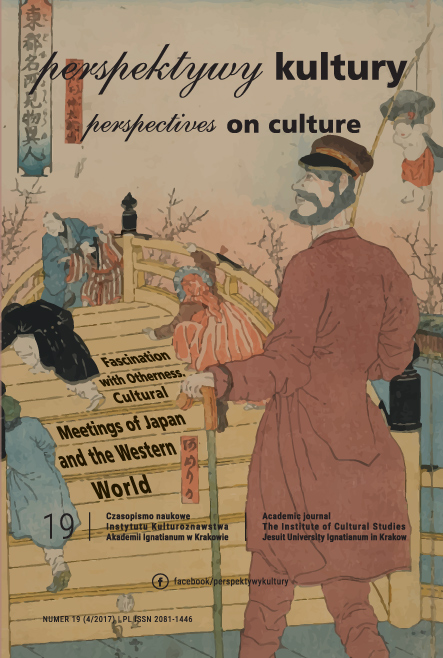Modern means of transport in tanka and haiku poetry of the Meiji and Taishō eras
Abstract
In this article, the author focuses on the modernization of Japan dur- ing the Meiji and Taishō eras, as it was reflected in the traditional Japa- nese poetic forms of tanka and haiku. Emphasis is put on the thematic shift in poems at the turn of the century, and selected examples of po- ems are presented to demonstrate primarily the application of terms referring to the modern means of transport which were becoming more common in Japan at that time, and thus gradually penetrating even into literature, including the sphere of lyric poetry. The author believes that at the turn of the century, the objects of modern society – being part of the new Japanese state – also became a form of the “new nature” depicted in modern Japanese poetry.
References
BEICHMAN, Janine. 1982. Masaoka Shiki. Boston: Twayne Publishers. Bicycles and Their Future Potential. Bicycle Museum – Cycle Center. [online]
Available from: http://www.bikemuse.jp/en/201501_PAMP_E.pdf [Acces- sed: 30th October 2017]
COBB, David (ed.). 2003. Haiku. London: British Museum Press. ERICSON, Steven J. 1996. Sound of the Whistle. Cambridge: Harvard University Press, p. 4. Cit. In: FORKIN, Matt. The miniature Train. Perry in Japan – a Visual History. Brown University Library Center for Digital Scholarship. [online] Available from: http://library.brown.edu/cds/perry/ scroll7_Forkin.html#ftnt6 [Accessed: 30th October 2017]
ERICSON, Steven J. 1998. “Importing Locomotives in Meiji Japan: Interna- tional Business and Technology Transfer in the Railway Industry”. Osi- ris. [online]. 13: 129-153. [Accessed: 31st January 2017]. Available from: http://www.jstor.org/stable/301881.
First Japanese Car. AutomotoStory – First Cars in History. [online] Availab- le from: http://www.automostory.com/first-japanese-car.htm [Accessed: 20th April 2017]
Gendai kashū [Anthology of Modern Tanka Poetry]. 1974. 2nd ed. Tokyo: Chikuma Shobō.
Gendai nihon bungaku taikei, Vol. 28 [Compendium of Modern Japanese Literature]. 1974. Tokyo: Chikuma shobō.
IKE Nobutaka. 1955. “The Pattern of Railway Development in Japan”. The Far Eastern Quarterly [online]. 14/2: 217-229. [Accessed: 31st January 2017]. Available from: http://www.jstor.org/stable/2941732.
ISHIKAWA Takuboku. 2002. Takuboku kashū [Collection of Takuboku’s Tan- ka Poetry]. Tokyo: Iwanami Shoten.
“Japan’s First Steamer Queen Victoria’s Gift”. West Gippsland Gazette. 23rd February, 1904. Available from: http://trove.nla.gov.au/newspaper/ article/68707261 [20th April 2017].
KENNEDY, Brittany. 2016. The History of the Japanese Bicycle Industry. [online] 30th July 2016. Available from: https://owlcation.com/humani- ties/The-History-of-the-Japanese-Bicycle-Industry [Accessed: 20th April 2017]
MASAOKA Shiki. 2002. Shiki kushū [Collection of Masaoka Shiki’s Haiku Poetry]. Tokyo: Iwanami Shoten.
MASAOKA, Shiki. Dassai Shooku haiwa. [online] Taiju’s Notebook. Availab- le from: http://www2s.biglobe.ne.jp/~Taiju/taiju_annex/1893_dassaisho- okuhaiwa_01.htm [Accessed 9th September 2013].
Mitsubishi Model A. Mitsubishi Motors. [online] Available from: http://www. mitsubishi-motors.com/en/innovation/history/year/1950/50_1.html [Ac- cessed: 20th April 2017].
STEVENS, Thomas. 1894. Around the World on a Bicycle. Volume II. From Teheran to Yokohama. New York. Available from: Project Gutenberg, 2004. http://www.gutenberg.org/cache/epub/13749/pg13749.html [30th October 2017].
SUZUKI Shinji, SAKAI Masako. 2005. “History of Early Aviation in Japan”. 43rd AIAA Aerospace Sciences Meeting and Exhibit. 10-13 January 2005, Reno, Nevada, USA. [online] Available from: https://arc.aiaa.org/doi/ abs/10.2514/6.2005-118 [Accessed: 20th April 2017].
WARREN, Jim. 1985. “Social History and the Photograph: Glimpses of the Singapore Rickshaw Coolie in the Early 20th Century”. Journal of the Malaysian Branch of the Royal Asiatic Society. 58/1: 29-42. [Accessed: 30th October 2017]
WINTERS CARPENTER, Julie. 2012. Seeing Kyoto. Tokyo: Kodansha.
Copyright (c) 2017 Jesuit University Ignatianum in Krakow

This work is licensed under a Creative Commons Attribution-NoDerivatives 4.0 International License.
Autor, zgłaszając swój artykuł, wyraża zgodę na korzystanie przez Wydawnictwo Uniwersystet Ignatianum z utworu na następujących polach eksploatacji:
- utrwalania utworu w formie papierowej, a także na nośniku cyfrowym lub magnetycznym;
- zwielokrotnienia utworu dowolną techniką, bez ograniczenia ilości wydań i liczby egzemplarzy;
- rozpowszechniania utworu i jego zwielokrotnionych egzemplarzy na jakimkolwiek nośniku, w tym wprowadzenia do obrotu, sprzedaży, użyczenia, najmu;
- wprowadzenia utworu do pamięci komputera;
- rozpowszechniania utworu w sieciach informatycznych, w tym w sieci Internet;
- publicznego wykonania, wystawienia, wyświetlenia, odtworzenia oraz nadawania i reemitowania, a także publicznego udostępniania utworu w taki sposób, aby każdy mógł mieć do niego dostęp w miejscu i czasie przez siebie wybranym.
Wydawca zobowiązuje się szanować osobiste prawa autorskie do utworu.





